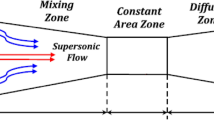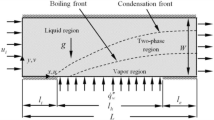Abstract
Theoretical and numerical analysis on the fluid flow and heat transfer inside a LNG evaporator is conducted in this work. Methane is used instead of LNG as the operating fluid. This is because; methane constitutes over 80% of natural gas. The analytical calculations are performed using simple mass and energy balance equations. The analytical calculations are made to assess the pressure and temperature variations in the steam tube. Multiphase numerical simulations are performed by solving the governing equations (basic flow equations of continuity, momentum and energy equations) in a portion of the evaporator domain consisting of a single steam pipe. The flow equations are solved along with equations of species transport. Multiphase modeling is incorporated using VOF method. Liquid methane is the primary phase. It vaporizes into the secondary phase gaseous methane. Steam is another secondary phase which flows through the heating coils. Turbulence is modeled by a two equation turbulence model. Both the theoretical and numerical predictions are seen to match well with each other. Further parametric studies are planned based on the current research.
Similar content being viewed by others
References
Patel, D., Mak, J., Rivera, D. and Angtuaco, J., 2013. LNG vaporizer selection based on site ambient conditions. Proceedings of the LNG, 17, pp.16–19.
Xu, S., Chen, X. and Fan, Z., 2016. Thermal design of intermediate fluid vaporizer for subcritical liquefied natural gas. Journal of Natural Gas Science and Engineering, 32, pp.10–19.
Fengxia, L., Yuqiang, D., Wei, W., Jiupeng, Z., Che, Z., Chao, D. and Dapeng, H., 2013. Feasibility of intermediate fluid vaporizer with spiral wound tubes. China Petroleum Processing & Petrochemical Technology, 15(1), pp.73–77.
Pu, L., Qu, Z., Bai, Y., Qi, D., Song, K. and Yi, P., 2014. Thermal performance analysis of intermediate fluid vaporizer for liquefied natural gas. Applied thermal engineering, 65(1), pp.564–574.
Xu, S., Cheng, Q., Zhuang, L., Tang, B., Ren, Q. and Zhang, X., 2015. LNG vaporizers using various refrigerants as intermediate fluid: Comparison of the required heat transfer area. Journal of Natural Gas Science and Engineering, 25, pp.1–9.
Menon, S., 2004. Piping calculations manual. McGraw Hill Professional.
Younglove, B.A. and Ely, J.F., 1987. Thermophysical properties of fluids. II. Methane, ethane, propane, isobutane, and normal butane. Journal of Physical and Chemical Reference Data, 16(4), pp.577–798.
Speight, J.G., 2005. Lange's handbook of chemistry. New York: McGraw-Hill.
Hestermans, P. and White, D., 1961. The vapor pressure, heat of vaporization and heat capacity of methane from the boiling point to the critical temperature. The Journal of Physical Chemistry, 65(2), pp.362–365.
Acknowledgement
This work was supported by a grant from 2016 Research Funds of Andong National University.
Author information
Authors and Affiliations
Rights and permissions
About this article
Cite this article
Chidambaram, P.K., Jo, Y.M. & Kim, H.D. Theoretical and computational analyses of LNG evaporator. J. Therm. Sci. 26, 132–137 (2017). https://doi.org/10.1007/s11630-017-0921-z
Received:
Published:
Issue Date:
DOI: https://doi.org/10.1007/s11630-017-0921-z




